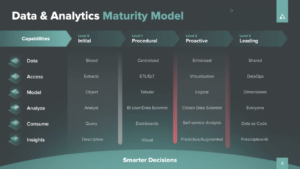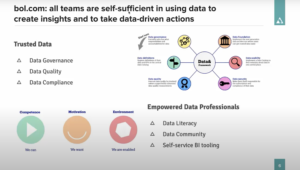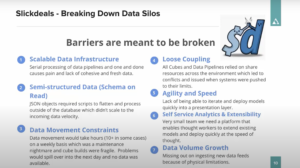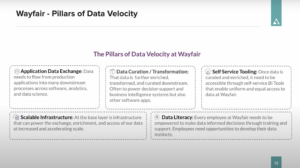
In our most recent webinar, four data-driven leaders from Cardinal Health, Slickdeals, bol.com and Wayfair joined us for a panel where they discussed how they are scaling smarter decision-making across their organizations and making data more accessible as a strategic asset. Couldn’t make the live recording? In this blog post, we share the highlights of what you missed!
For this webinar, we were thrilled to have Dave Mariani, AtScale Co-Founder and Chief Technology Officer moderate our panel of data-driven leaders which included:
- Maurice Lacroix: Maurice has been a key member of the BI team at bol.com since 2017. Prior to bol.com, he had various BI consulting in Marketing and Telco. Maurice was responsible for the implementation of AtScale and Tableau on the Google Cloud platform. Currently, his mission is to deliver the best possible user experience with this technology stack.
- Jenni Wheeler: Jenni is the Director of Data and Analytics for the Pharma segment within the Augmented Intelligence organization at Cardinal Health where she leads a team focused on transforming data into a single, innovative, cloud-based solution. Jenni has been involved in data and analytics strategies, projects, and operations for over 15 years. Her customer/business first mindset is inspiring those she works with to embrace the transformation journey to a digital first mindset.
- Greg Mabrito: Prior to leading Data and Analytics at Slickdeals, Greg was an integral part of the Big Data and Infrastructure team at H-E-B for over 15 years. As a technology leader, Greg is constantly looking for opportunities to find new ways to approach solutions. He is passionate about using technology in the most efficient way for the fastest, most scalable results.
- Matt Hartwig: Matt is the Product Lead within Wayfair’s infrastructure organization where he leads a team focused on the data and technologies the company relies on. Matt has extensive product management, BI/analytics engineering, and Financial Operations Analysis experience including time Verifone and Curb.
In this data & analytics model, Dave outlines where our panelists and their teams currently reside and how you can compare their status to where your team currently stands. He shares that most of our panelists are advanced in their model as they are in the “Leading” category of maturity.
Mariani walks us through the four levels and capabilities, sharing where most companies begin with their “fairly siloed data” and BI tools and how they can advance to “true DataOps” to combine data virtualization for real-time access and analytics consumption.
He recalls the importance of laying the foundation down correctly in the early model capability as “When you’re just importing data into a BI tool that the report or the BI tool itself becomes the model. That’s not very good, for sustainability and for sharing that data, and enhancing it in the future.” Dave continues to outline the following stages by sharing how teams can make their data more consumable across the board so that they can make smarter decisions with their data.
“Our mission is still unchanged. We want all teams to be self-sufficient in using data to create insights and to take data-driven actions,” says Maurice Lacroix. How will his team achieve this in 2021? He shares that they focus on two pillars: trusted data and empowered data professionals. When Maurice thinks of “trusted data” he reflects on implementing data governance and “finding the right owners” who understand the responsibilities that come with their role. When discussing data quality and compliance, Lacroix prioritizes the reconciliation of data sources and ensuring that professionals can work with their data.
Maurice shares how his team is able to reach a level of self-sufficiency, sharing that “We have a data literacy program where we train and coach teams on various aspects of data literacy and try to get them to the next maturity level. We’re facilitating a community of data professionals within of all those columns so that we can exchange best practices and learn from each other.”
What did the Cardinal Health team want to do differently with their analytics? Jenni Wheeler shares the question her team had to ask themselves, “How do we make sure we’re not just creating another data platform that will be used the way we used all the other data platforms?” She continues how they, “Really focused on core foundational elements” to “change the way we leverage our data.” What were these elements? Wheeler and her team prioritized: Data Ownership, Product Focus, Shared Backlog, Simplification, Common Controls and P&L Focus. By adopting this new philosophy, her team was able to define how they want to leverage data and analytics while moving into different levels of maturity.
“In 2020, this is where things started to break. We had to make a change and break down silos and move to new technologies,” says Greg Mabrito. Greg walks us through the journey that Slickdeals, sharing the early challenges, “What we were after was a scalable data infrastructure. We suffered from serial pipeline processing and when we would have a cube build fail to be able to restart that entire pipeline it would take eight hours in some cases, and a business wouldn’t have their data until the afternoon.” Mabrito highlights the seven barriers that needed to be broken and how they were able to achieve scalability, agility, and self-service with his small team.
“When we’re a $50 billion company, what do we want to look like? When we’re a hundred billion dollar company, what do we want to look like? The answer wasn’t, ‘We want to triple the size of our corporate BI team and central BI team.’ The answer wasn’t ‘We want to triple our data engineering organization.’ Instead we have pivoted into a model where we’re federating out all of these functions and embedding it as a part of how we work in every space.” Matt Hartwig, shares the core pillars of velocity and what it means to his team at Wayfair and how their strategy to hire and empower a data-driven team.
Where to, Next?
What did the data & analytics journey look like for these leaders and their teams? Where does your team reside in the Data & Analytics Maturity Model? Find out by watching the on-demand webinar here.











SHARE
Guide: How to Choose a Semantic Layer